A cultural context
Tucumán, Aguilares, late 1960s. Some turbulent years from a social perspective, marked by the repressive and tragic dictatorship that had begun in 1966 with Onganía and which, among some of its less notable notes, was the closure of the sugar mills. from the province. A new social reality that was going to mark the lives of thousands of furrow and mill workers, who from one moment to the next lost a large part of their livelihood that moved them in the day-to-day life of a province in crisis. In this context, which was also going to be marked by the increase in social conflict, different uprisings took place that to this day are recorded in the retina of witnesses of the time: the Tucumanazos. Streets with barricades, repression and blood colored the lives of ordinary citizens. In this area, the culture echoed a reality and that is where the “Tucumán Arde” appeared in 1968, as a means on which to show outwards what was the reality of hunger that was happening in the land. In this spiral of conflict and violence, the province positioned itself as a relevant cultural pole: cinemas and theaters were a reality for large sectors, especially the former, which meant a moment of recreation for the middle class. That did not rule out the existence of spaces such as dances, where the popular sectors came to spend their sorrows, and young people could be guided to the sound of period orchestras that little by little left tango, jazz and pasodobles to try their luck with tropical rhythms. that were gaining more and more notoriety. However, in that musical world something new, different, began to catch on. Was it a new British invasion? Guitarist Luis Albornoz, who was part of Los Sabuesos, La Pequena Banda de Trícupa and Redd (among other bands) tells us that the image of The Beatles was recorded in his retina at some performances at the old Plaza Cinema, in those previews between movie and movie. The reality for many young people was going to be different, musically speaking, but the time will come to stay in San Miguel. The question here is what was happening in the south of the province? What was happening in Aguilares? A sugar city that found itself at the crossroads of the Onganiato’s policies was no stranger to the new local economic scenario. In this world were two young music enthusiasts, Jorge Arias and Ramón Antonio Soria, at the time students at the Nicolás Avellanda National School. On a bench in Plaza 25 de Mayo, the main square in “the City of Avenues,” they decided to put together a band in a fairly rudimentary way; In Jorge’s words, a guitar and a bass drum served as the base on which the adventures that were accompanied by the working families began. In the search to form a band, the rumor reached the ears of the young people that there was another music fan in the neighborhoods of Aguilar, a folklore guitarist but dedicated to plucking. That young man was José Rojas, “Pepe” to his friends. Both Ramón and Jorge agree in thinking about the challenge of convincing “Pepe”, prominent as a folklorist at that time, to join the ranks of a rock group. Memories involved, which may appear somewhat diffuse to memory, the young guitarist from Aguilar closed ranks with Soria and Arias, joined by one of his brothers for a short time, Alberto. The set was already there, but…and now? The instruments were missing, but the musicality and desire were there. Memories about Pepe emerge in the words of Jorge, Ramón and his other brother Victor Hugo: he was the musician of the band, who based on his ear and abilities was going to mark the short but intense path of the band that was about to fall.
The band is formed: let’s add ages
In that enthusiasm of youth, Jorge, Ramón, Pepe and Alberto reach an agreement on the name: Sonido ’74. But if we are between the end of ’67 and the beginning of ’68, where does that name come from? With the band members present we found the same answer: 74 was the sum of the ages of all its members. Some of the creation was already underway, but what about the music? The criolla and the bass drum would be left behind, Pepe’s folklore plucks. Rock was present, even in what was often disparagingly known as the interior of the interior. This new rebellion was going to be framed in two spaces, that of the new wave or music that by 1968 had become dance (Los Iracundos, Los Naufragos, Industria Nacional or Trocha Angosta, for example) and on the other hand the growing national rock with the original triad: Manal, Almendra and Los Gatos, who had been leaving that new wave to harden their sound. These views on musical culture affected the decision of Sonido ’74, which had to focus on finding instruments that would place them within an underdeveloped area in the south of the province. On the phone, Alberto Rojas comments that the scene was boiling: in Concepción there were Los Rebeldes, Sonido Beat and in Juan Bautista Alberdi, Noche Corta. This scenario was marking a horizon to break a glass bubble for the young people of Aguilar. Beginning of ’68, and the instruments were about to fall. Ramon Soria comments on this in his memory, saying that Arias, with great effort, arrived in Buenos Aires, with some family support, to acquire the instruments at Casa America. But what about the money for the adventure? where did it come from?. Here the versions and memories intersect between a mysterious man like a fairy tale, the favor of the owner of a candy store, as well as the role of a lender with a certain good heart. Be that as it may, Arias left full of hopes and returned with the necessary inputs to give free rein to the dreams that came from the meetings. The first guitar, Pepe’s, was already finished. According to the testimonies, to a greater or lesser extent, a carpenter together with members of the band put together an instrument with a unique and peculiar figure, with a classic color that according to Victor Hugo (Pepe’s brother) did not like, going through “sheet metal and paint” to have a cream color that stood out even more. The practice began and a New Wave style flooded the aesthetics of the group as can be seen in this photo from March 1968, where Sonido ‘74 plays at the 15th birthday of Jorge Arias’ sister.
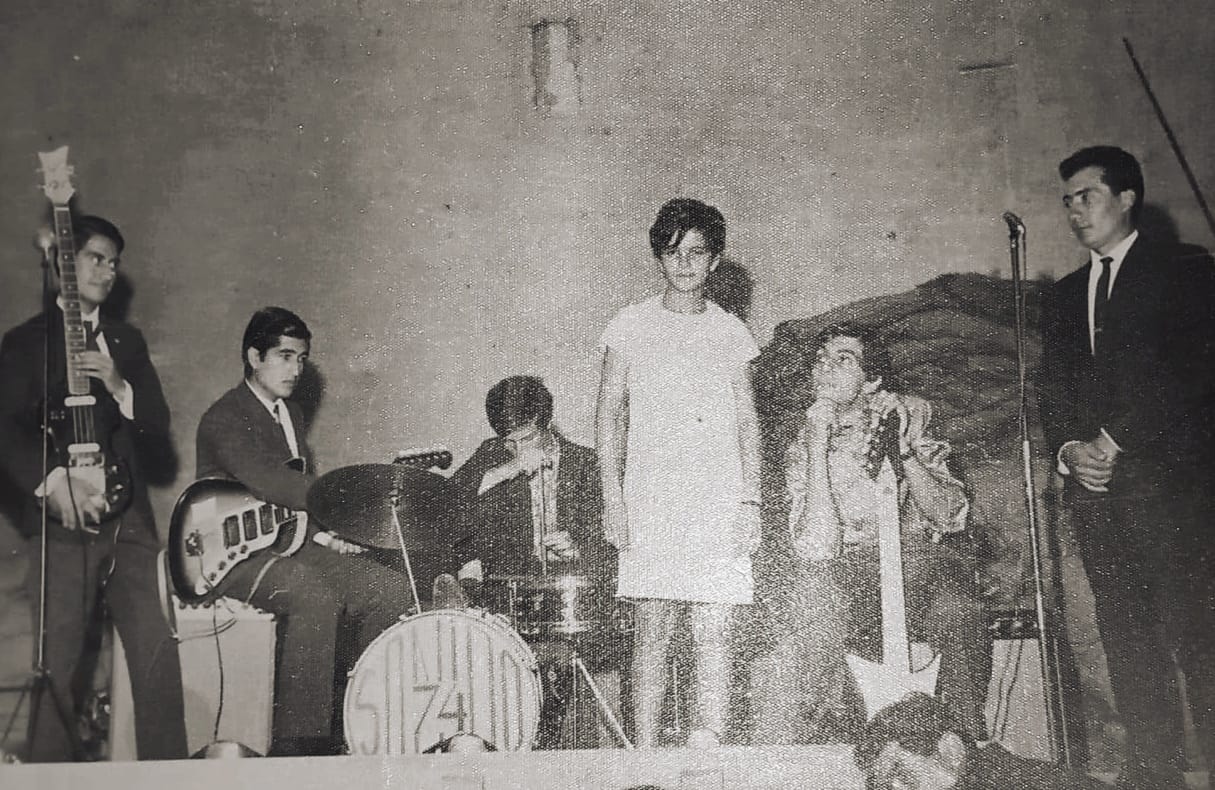
It is he who remembers the group’s first official recital at the Corralito Festival, a space located between Alberdi and Escaba. Ramón Soria remembers it in another way: Puerto Montt, the classic of Los Iracundos in a radio program on LV12. The anecdotes may be incidental, but the cultural views of the moment allow us to see that reality, Sonido ’74 as a dance group, in the manner of Los Rebeldes or Noche Corta. With the beginnings, difficulties began. In his interview, Ramón tells about his little knowledge of the drums and how to set them up above all, with a consequent somewhat bitter memory that awakened his resilience: after a recital where he was able to share the stage with Teddy Chumba, Guinness record for endurance for playing the drummer, he was able to feel the emotions firsthand, causing negative and positive watersheds at the same time, and the band planned to leave to make room for another; but it was perseverance and drive that led him to perfect himself on the drums constantly and consciously. Jorge gives an account of that resilience, which was part of the whole. Together with Aldo Priotti, a relative, who acted as manager and presenter, the group played to become known. Time and personal reality marked a change at that time: for personal reasons Alberto left the band and his brother Victor Hugo Rojas joined the bass. Sound was already established: • Jorge Arias: rhythm guitar and voice • José “Pepe” Rojas: first guitar • Víctor Hugo Rojas: bass • Ramón Antonio Soria: drums
Here we take the role of the Arias family in the advancement of the band; Jorge says that his father “Don Arias” had been a worker at the Aguilares Sugar Mill until 1955 with the military coup that overthrew Juan Domingo Perón. With the arrival of the military government, Don Arias was fired from the mill due to his militancy, a common denominator for many workers in those dark times. That forced the family to look for new ways to survive in Aguilares, with family kiosks and finally with a kind of SME, as Jorge tells us, where they bought the bags of sugar that could not be sold in the port, which were damp and somewhat broken they returned to Aguilares. Once here, the bags were opened, washed in the then healthy Medina River, and mended to be deposited in a warehouse, to be filled again and sold as second-class sugar. It is in this shed where the band rehearsed almost daily, Ramón remembers the stacked burlap bags, Victor Hugo in more depth says that they played in the afternoon until dusk, and that they noticed when they left how the neighbors and passers-by gathered at the doors of the warehouse to listen to those young people whose music was beginning to appear among their repertoire that was not so danceable.
1969: amplification
We are already in 1969 and the young people in suits from Sonido ‘74 were beginning to mix some of Arias’ own songs, with material that came from Buenos Aires. We are at the moment in which the initiatory triad of national rock was beginning to gain strength. In fact, Jorge comments that they reached a point where they were in the dilemma of adding an organist and continuing with the dances or remaining an increasingly electric and rocking group. With this we are entering the second stage of the band, which is shown in this photo that is considered the inauguration of the Plaza bar and where, although we can only see Ramón and Pepe, we can notice drawn faces on the drum drum and the hippie peace symbol. An entire declaration of principles.
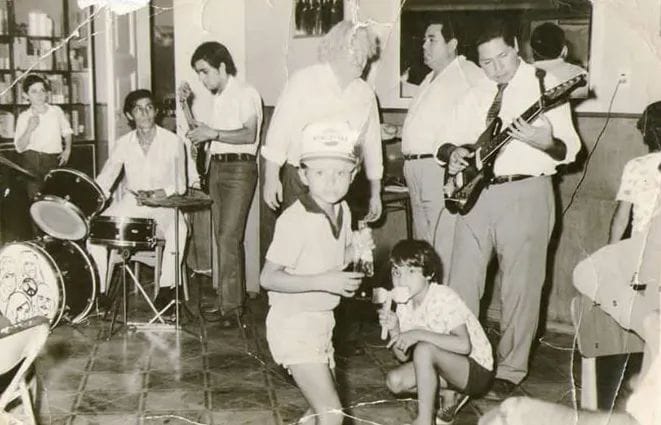
Photography by Victor Hugo Rojas
Although San Miguel de Tucumán was an important cultural center at that time, this was not a common denominator for the entire province. Where did the new recordings arrive in the city of Avenues? In the old Amambay record store, today converted into a gift store as part of the tragedy that attacked this northern world in recent decades. Jorge comments that around there he managed to get a family member on a trip to Buenos Aires to bring him something new from the Buenos Aires record stores where the world of rock was in immense ferment. These were beginning to be the most rocking times for Los Gatos, with the incorporation of Pappo for “Beat N. 1,” their fourth album; Manal with his “bomba” and Almendra with the conjunction of poetry-lyrism of Spinetta and the rock imprint of Edelmiro Molinari that would break the molds at the beginning of 1970, Vox Dei with his “Cuero” would be another song and turning point for Sonido’ 74. We entered the second stage of the band, focused on covers but also on some of Arias’ own compositions that they played live. Almendra, with Muchacha Ojos de Papel, Ana No Duerme and Tema de Pototo, as well as “Cuero” by Vox Dei in its entirety, were the group’s repertoire. Thinking about the rehearsals from our present leads us to imagine that work of lifting and resting the arm of the console on the long play, all to make the songs sound as close to the artist as possible. Little by little, Sonido ’74 was improving and the new concerts they did began to involve venues in the interior of the province and San Miguel. They were the rock group par excellence of Aguilares, playing in spaces such as the Socorros Mutuos hall in the city, where Victor Hugo remembers that they shared the stage with Los Fantasmas and even Los Sabuesos, something that can be confirmed since Luis Albornoz of the latter group remembers that their first recital was in Aguilares. Jorge Arias comments on the astonishment that a group like Los Fantasmas aroused in him, being the first time that he saw elements that went beyond the budget.
The boom and the projection?
At some point in ’69 / ’70, a businessman from the capital decided to hold a rock band contest with monetary and exhibition prizes. This is something that both Ramón and Jorge pleasantly remember with a certain grace. Sonido ’74 wins that contest, according to the latter because they were the only band from the interior and they would have no problem not receiving the monetary prize. Yes, something was accomplished, being the opening act for Vox Dei and Almendra at the Estudiantes Club in San Miguel de Tucumán. The dates are vague, but we can think of the year ’70 especially because of the role that those bands had for national culture from that year on, a true explosion. Following Ramón’s story, the memory shows a large number of people both inside and outside the club, everyone went for Vox Dei and Almendra. The doors were closed and the crowd gathered. The result? Repression in the vicinity and opening of the space for a full house. With a drum set pushed a little to the side of the stage, Ramón cannot see the crowd, a blue light prevented him from seeing beyond “shadows.” In that context, Sonido ’74 came out to play, being presented to a general silence, “who could know us?” he says. In the midst of the silence, a “miguelito” flew into the air, bursting into a sound wave that resonated throughout the space. From that moment on, one thing was certain, the band could be something more. A final stage of power was beginning to take shape, where the whole thing was greatly oiled. The members of the band agree that they traveled to San Miguel de Tucumán whenever a musician or group from Buenos Aires came to play, for example Manal. With this new reality, Sonido ’74 was beginning to create something of a personal repertoire, but what did these songs revolve around? Both Jorge and Ramón account for a priority element in the music, rock was mixed with folklore: a kind of Santaolalla Rainbow. The context was conducive and the skills they were acquiring with practice allowed them to deepen that repertoire. Jorge will say, we wanted to have an impact in the province; Ramón, meanwhile, longingly thinks about a possible national projection…at the same time Victor Hugo remembers the odd festival in Aguilares during the carnival season, in which they performed, a particular one that took place in the Arroyo Barrientos area, “ very remembered.”
Postlude
Jorge, Ramón, Victor Hugo and Pepe were young students. During this time with Sonido ’74 they were passing their secondary school. What could be expected at the end of the cycle? The glass jar had broken, but we had to think of something specific to the moment in which the music inside was. It was not easy to be a rock musician in a space that was not Buenos Aires, the record companies required the band to stay in the Capital, with tours aimed at promoting simple songs that according to the reception, they will lead to the creation of a Long Play. The band’s material continued to be mixed with covers mostly, Beatles with Let it Be and Good Day Sunshine or Creedence Clearwater Revival, with Green River for example. Sonido ’74 seemed to be established and be a firm representation of Aguilarense rock: they had already been to Radio Nacional’s Club del Beat, to LV12, they had been the opening act for Vox Dei and Almendra, and had even appeared on the almost mythical Caja N° 10 , Channel 10 musical program. But social reality sets an agenda in the daily life of the group, the adventures of life itself. High school was ending, and with it the time of the band, you had to study or work. Sonido ’74 was recently renamed Fornax; Jorge Arias comments that it was in astronomy classes where he came up with the name, since the sum of ages had already surpassed ‘74 and the maturity of the group led to that name change. In that instance, a new main voice was added, under the figure of “Chueco” Saavedra. Between 1970 and especially 1971, the reality of the end was on the horizon and it actually occurred. There are few photographic records left of the band, it was not common as it is today. The penultimate presentation of the group as such took place on Jorge Arias’ graduation day, a moment that is immortalized in this photo in the hallway of the Nicolás Avellaneda National School.
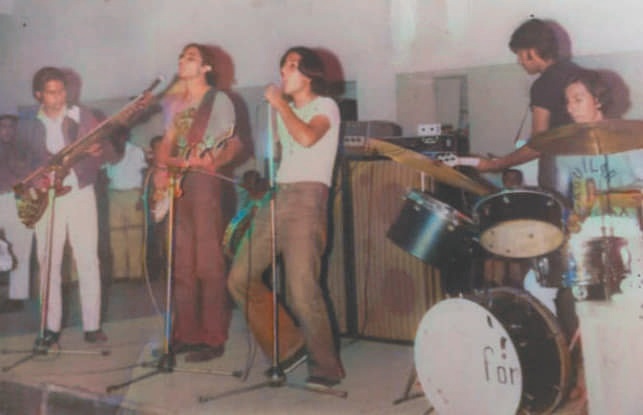
The suits had been left behind, the cultural issue was present throughout the country, long hair and flared pants in the same tone were the closing of a short but intense career, which marked the retina of Aguilarense society, which today when encountering Some of its members affectionately call them by name: “Sonido”.
The “Nueva ola” hits Concepción: Los Rebeldes and Sonido Beat
Think of rock as a way to build cohesion among youth. As in Aguilares, the situation of popular music within “La Perla del Sur” had a little more development in reference to popular musicians. Here the role of the orchestras that were in charge of making the dances a little more lively was being converted towards a reality of the 60’s that moved the music scene towards dance. The 60’s, in terms of culture within Concepción, was very different from what we can perhaps know and understand today: cinemas, dances, candy stores and record stores like the Courtade family’s. The latter will be one of the pillars for the emergence of this rock and beat movement that will take place in Concepción, a space that, as Carlos Pedraza, organist of Sonido Beat, recalls, allowed him to listen to musicians like Jimi Hendrix. In short, all this was built as a combo that, being so mixed, only one reality could fit: emerging and animating.
In this context, musically speaking, the orchestras were the main center in the cultural decade of Concepcion, with common spaces that they shared in the south of the province. Part of the musical evolution marked the passage from an orchestra as we have imagined it, to an expanded ensemble that revolved around the figure of a main man within it. Thus, the figures of Lito Taboada and Henry Varela were the greatest exponents and are a common denominator of some memories that circulate about the time. They give us a glimpse that in these groups tropical rhythms were mixed with some rock, twist and little by little Beatles songs that flooded the fashions of youth.
Think of rock as a way to build cohesion among youth. As in Aguilares, the situation of popular music within “La Perla del Sur” had a little more development in reference to popular musicians. Here the role of the orchestras that were in charge of making the dances a little more lively was being converted towards a reality of the 60’s that moved the music scene towards dance. The 60’s, in terms of culture within Concepción, was very different from what we can perhaps know and understand today: cinemas, dances, candy stores and record stores like the Courtade family’s. The latter will be one of the pillars for the emergence of this rock and beat movement that will take place in Concepción, a space that, as Carlos Pedraza, organist of Sonido Beat, recalls, allowed him to listen to musicians like Jimi Hendrix. In short, all this was built as a combo that, being so mixed, only one reality could fit: emerging and animating.
Something very specific that guitarist Luis Brito raises is that these orchestras were dedicated to playing at dances and carnivals, so they inevitably had to play what the public requested. A no less interesting fact about these groups is the role played by drummer Hugo Néstor Chumba, better known as “Teddy Dinamita” Chumba, who for many years was able to maintain the Guinness record for endurance of playing the drums for 56 hours and 46 minutes. From that point on, his reputation stood out above the rest, even receiving a CAF battery as a reward for it. This idea of promoting popular work continued for decades, where musicians such as Johnny Salvatierra on guitar, Curro Sueldo on bass, Roberto Gramajo or Luis Brito himself were molded in these orchestras. In this sense, these possibilities were opened to other groups such as Los 4 del Ritmo already in the 70’s. Among these groups, the role of Teddy Chumba stood out, a drummer who for many years maintained the Guinness of resistance and who had an active role for a few decades.
In this environment, the influence of the New Wave wreaked havoc on adolescent perceptions and thus the first groups such as Los Ramblers appeared, which as a youth group moved away from orchestras, playing rock and roll and twist. According to Carlos Pedraza, his cousin “Pilín” Pedraza was one of the creators of the new music that was circulating among the kids around 1965. However, as they made a name for themselves they began to play “everything.” From there the band’s trajectory was diluted into other groups that changed towards Los Dolares and then towards the 70’s Luz Roja. Music as a flag: Los Rebeldes Another of the groups that continue to remain in the memory of the imaginaries of that time is that of Los Rebeldes, a group of young people who attended secondary level and who between the end of ’68 and the end of ’71 made their journey with great zeal. Two of its protagonists, Jorge and Eduardo Carrizo (not related) spoke about their memories of one of the leading bands of “La Perla del Sur” in terms of New Wave and Beat rock. According to Jorge Carrizo, Los Rebeldes had some influence since they were able to play in other cities and provinces, but all from an amateur perspective. “All our teams were bad”, getting ahead was an act of resilience and that was what they sought to carry forward, with love the music comes out. The technical conditions at the beginning of Los Rebeldes were quite poor, but the desire was stronger. Thus, a wave strongly linked to Los Iracundos began to be created in their repertoire. Music, according to Eduardo, is born in the third year; The first performance was at a fair to raise funds for the School of Commerce. It was at a festival of modern rhythms that took place in the old Pablo Haimes gym, current Plaza where, among other musicians, Luis Brito from Los 4 del Ritmo also played for the public for the first time. The simple fact of forming the group was a reward. At that time, and during the short but intense tour, Los Rebeldes formed with: – Jorge Carrizo: singer – Eduardo Namur: rhythm guitar – Eduardo Carrizo: first guitar – Juan Aquino: electric bass – Ramón “Cholo” Barrera: drums
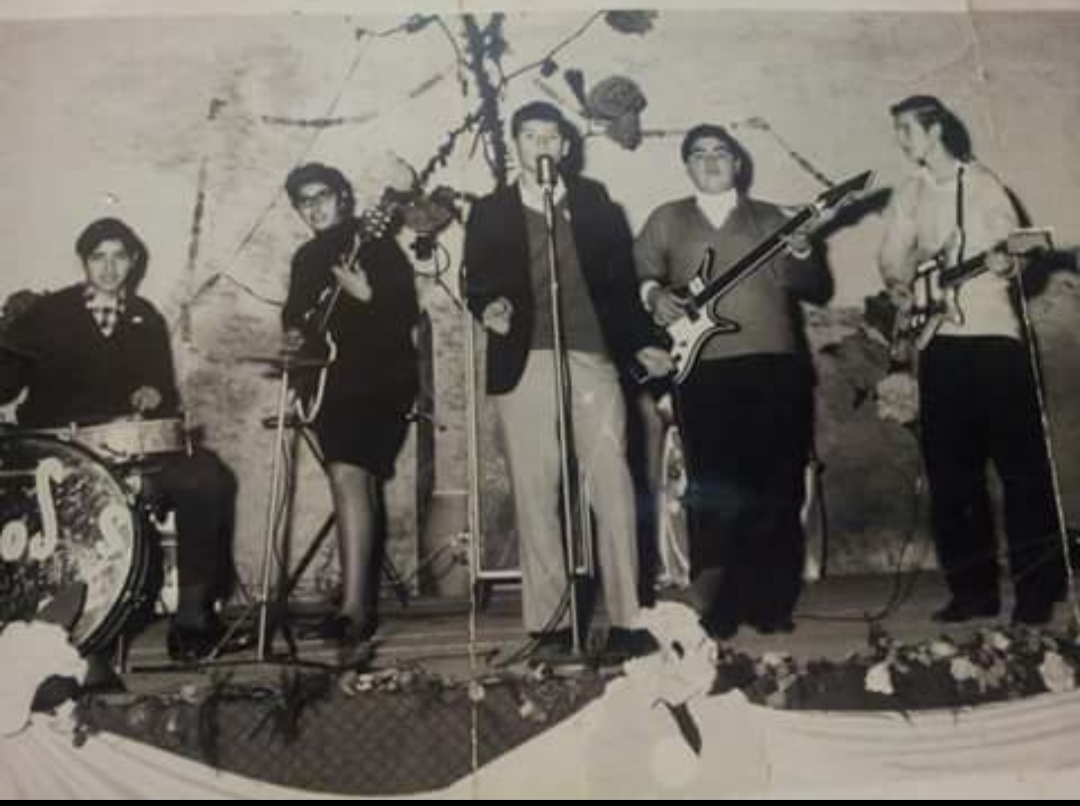
Acquiring the instruments was not an easy task, and some guitars and bass were obtained by purchasing them from members of Los Ramblers. The vocal equipment was difficult to acquire, but he was able to obtain a Tronlite equipment, two four-column speakers, thanks to a loan that was returned. Its characteristic was a sound effect for the first guitar that gave a reverberance, which made the instrument very similar to what was heard on Los Iracundos’ LPs. In his role as lead guitarist, he was able to assemble his instrument like a jewel, the neck of the guitar was made of stainless steel. The drums consisted of snare drums, bass drum and cymbals. As Eduardo says, “music is something so good, it unites,” something about which Jorge agrees and explains how the time of Los Rebeldes was a unique moment in their lives.
Los Rebeldes, indeed, in their beginning as a student group, did not stop being a fight against parents who did not want their children as professional musicians. There was established that enthusiastic spirit of the group that caused them to rarely receive any payment for playing: at the inauguration of the Bar Plaza in Aguilares according to Jorge and on the tour to Salta (Apolinario Saravia) according to Eduardo. As a student group they had a strong impact with all the youth, even being able to play in the amphitheater of the Nuestra Señora de la Consolación School, being one of the first (if not the first) rock groups that entered that religious institution. Among so many festivals, they were able to play at the Potato Festival, which was of relative importance since, according to what Jorge says, it brought together different winners from local festivals, which gave it a certain renown. The colorful note is that they were hired unexpectedly, since it was Los Iracundos who were going to perform, but a defect along the way forced the organizers to call those who did it as well as them: Los Rebeldes. That was a kick, which allowed them to play in the Municipality of Concepción, also in front of the Caja Popular.
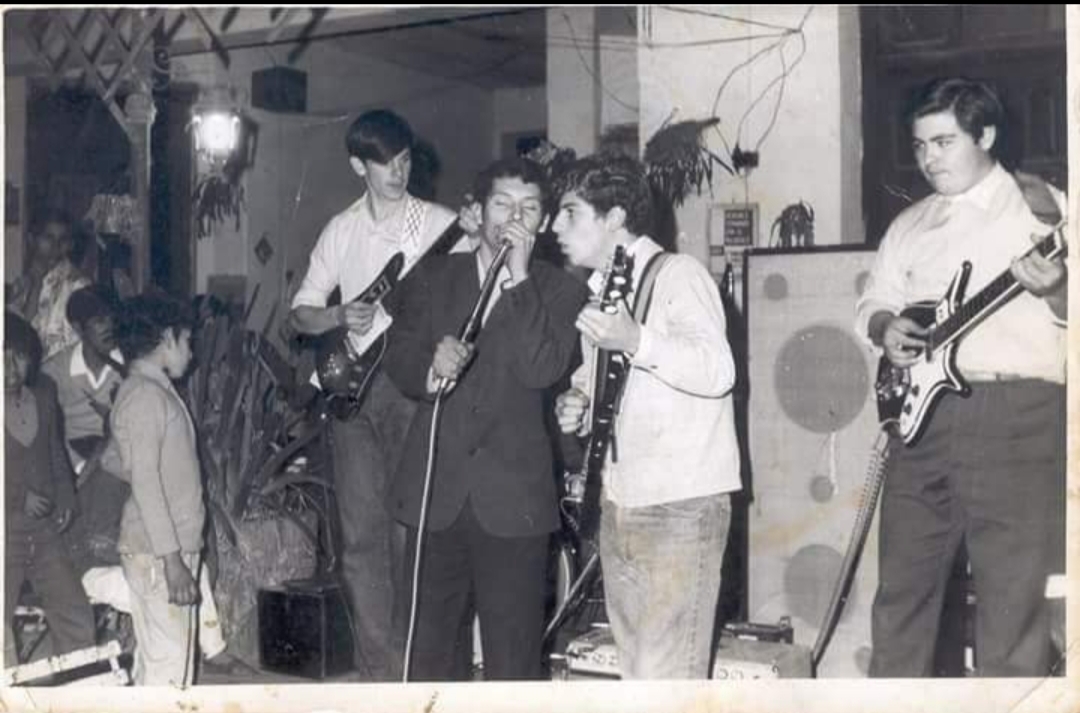
As Eduardo Carrizo says, during carnival times they were hired for different parts: “you had one ticket (…) and then in another place (…) we were there all night.” The teams moved in a rural Fiat 1500, and that allowed them to quickly shorten the distances. Many of those performances took place in Aguilares and Juan Bautista Alberdi. Eduardo remembers that in Aguilares in particular there were modern music contests where people voted, through the purchase of a ticket, for a particular band. In this context it is worth thinking, where were the tests carried out? Simple, in a garage half a block from Plaza Miter in Eduardo Namur’s house. And that allowed them to play in downtown Concepcion, at the Confitería La Estrella, at the King Gallery, the old Odeón cinema and at the Boxing Club. They are memories that are present in the memory of both Jorge and Eduardo, especially with La Estrella, where they remember that they were hired every Saturday and that in that situation they had some waiting requests from the parishioners of the Cathedral to start with the show.
Those were times of paying to play, remembers Eduardo. The first Los Rebeldes team was purchased on July 20, 1969, brand Ucoa, coinciding with the arrival of man to the moon: “we go to see the team, and in the window of the business where we bought the team, it arrived “man to the moon.” The little that was managed to be obtained was allocated to the whole.
By this time, beat songs were being added to Los Iracundos’ repertoire: Los Náufragos, Los Gatos, La Joven Guardia, Industria Nacional, Trocha Angosta. In this sense, all the records were obtained at the Courtade record store, something that allowed them to access the latest record releases. These extras from the repertoire continued to be replicated at festivals and cafeterias, but the fact of not having a representative they believe prevented them from going further, since they were unable to appear on radio or in Box N. 10 of Channel 10.
According to Jorge, despite the difficulties, they managed to tour Salta. In particular, they went to Apolinario Saravia, in a hired taxi where, with all the instruments in tow, they were able to play two nights in a row. It is fondly remembered that they put together the posters to disseminate the presentation, something that showed the internal union between them. With significant success among youth, they were already beginning to share the stage with Sonido Beat. These two groups were showing their imprints in front of the Concepción public, but particularly the case of Los Rebeldes would come to an end between the end of 1971 and the beginning of 1972, high school had finished and given the impossibility of devoting themselves professionally to music, as The parents said, it led to the end of the group and turned it into a pleasant memory today.

Rock, rock and beat: impressions about Sonido Beat
Among the bands that stood out, and beyond Los Rebeldes, also appears Sonido Beat, which begins “in a Carnival summer when they hire him to play at the Miguelito Miguel recess in Trinidad” according to Carlos Pedraza. There, with his piano accordion, he meets the Jatip brothers, forming the short-lived Group 70, just for that carnival. “Tato” Jatip, Daniel Jatip and Hugo Jatip, guitarist, bassist and drummer, plus “Pinky” Jatip and Pedraza. In May 1970, the brothers obtained a loan to buy instruments and sound, one for the guitar through which the guitar came out and a Tronlite that Los Rebeldes also had, along with a “spell” equipment from an electronic engineer from San Miguel de Tucumán, Miguel Serrano, more of a bass waffle where the keyboard and bass came out. According to Pedraza, that is the founding moment of Sonido Beat
“Tato” Jatip: first guitar and voice
Daniel Jatip: bass
Hugo Jatip: drums
Raul Chicco: voice
Carlos Pedraza: organ and musical direction
A common denominator with respect to the other bands was that everyone, except for “Tato” were students, and finishing high school was synonymous with studying or working, different times where the reality not only of the capital, but of Concepción, marked life. Of the youngs. Devoting himself to music was not an option, and that is something that is evident in the memories, often moved by the words of his parents. And despite that one realizes knowledge and facilities for music, such as the cases of Eduardo Carrizo from Los Rebeldes, Carlos Pedraza who, beyond his profession, continues to dedicate himself to music today, or Hugo Jatip, about whom Pedraza He affirms that he had incredible skills with the drums, not only “bringing out” songs but also that in recitals he could provide his own imprint; “He was a guy who lived creating,” says Pedraza.
The repertoire was not tropical music, but with some elements of the popular beat of the moment such as Los Náufragos, Trocha Angosta and Industria Nacional. Always following Pedraza’s word, the strong ones however were The Beatles, Creedence Clearwater Revival with “Ramble Tamble” (with which they won a rock contest in Simoca). In Aguilares, with Birthday by The Beatles they also won a festival; a repertoire that made them different. In that context they became known in Concepción in leaps and bounds, something that the youth pushed and led them to go in 1971 to play in Córdoba in clubs and social clubs. Beyond that, in their short life they were able to play in the province in Famaillá and Bella Vista.
Regarding the instruments used, Carlos fondly remembers that his organ was a Philicorda acquired at Casa Allende in San Miguel de Tucumán, which could be obtained given the economic circumstances of the time. Regarding the guitar, “Tato” had bought it from his cousin “Pilín” and the color information appears when he arrives at a rehearsal, let’s listen to it in the words of Carlos himself. When he arrived for a rehearsal day, he received a quick response from the guitarist: “There is no rehearsal today, the guitar is disassembled, because I’m tired of pedaling.” The guitar actually had a floor distortion pedal, the result? “Tato” disassembled it himself, including the guitar, which he dug up and put the device to activate using a button on the body of the guitar. The first guitar came out very well, remember, as did the songs in English. The drums were a graft where some parts were not useful, so Jatip bought a CAF snare drum and Istanbul cymbals.
In their short moments they were able to reach the old LV12, where they were able to go live being presented by “Cacho” Viotti and Etta Guzmán, two excellent announcers of the moment. Forging an identity of Sound Beat, they were able to create a memory in the people with a song known as “El loco Luis” that they played at a festival at the Concepción Fútbol Club stadium as the opening act for Alma y Vida, one of the groups of wind most remembered by collective memory. Sonido Beat played Del gemido de un gorrión and La Gran Sociedad, with arrangements that he remembers as almost perfect. They were also opening acts for Los Náufragos, Elio Rocca, Jorge Cafrune and “Marito” among many others. Internal conflicts arose, and beyond arriving towards the end of the young people’s course, it put an end to an adventure that remains pleasantly inserted into the memory of its protagonist.
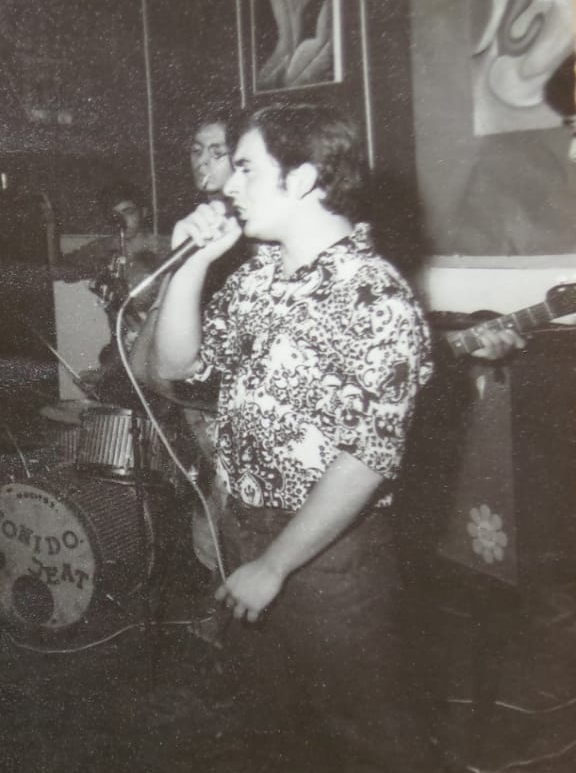

Comments
No comments yet. Be the first to react!